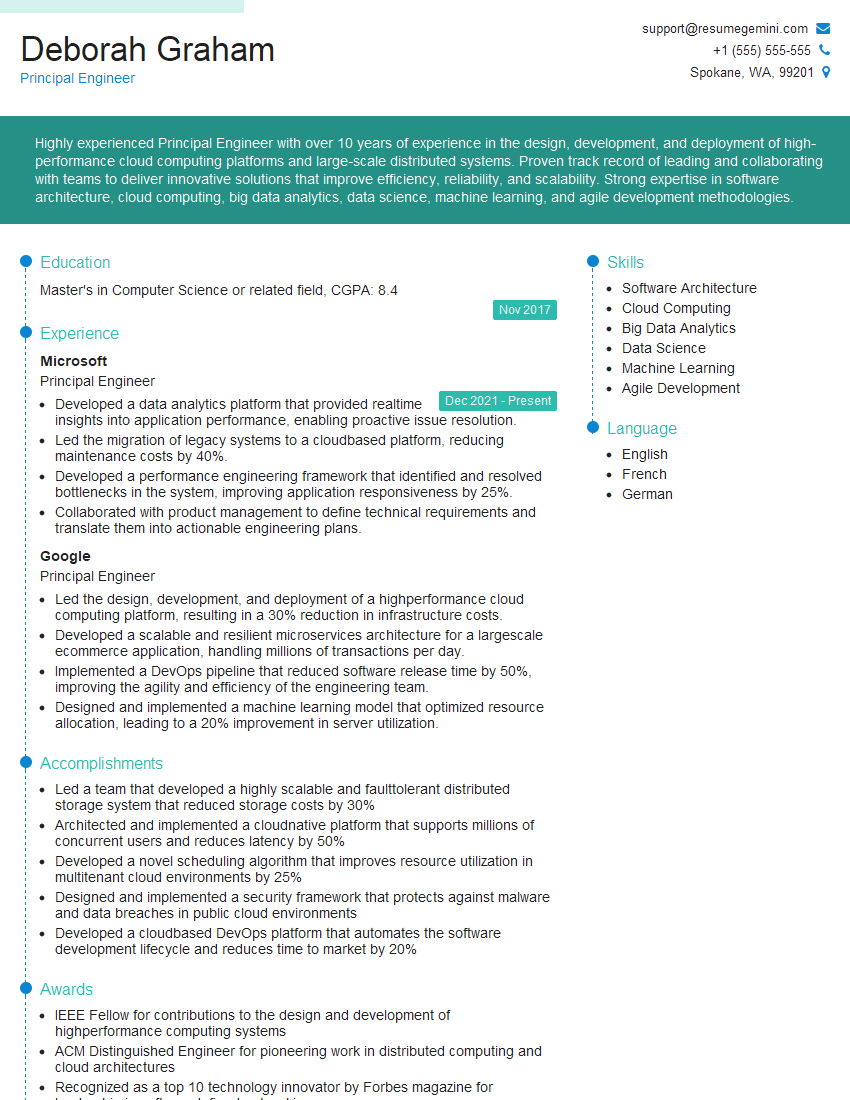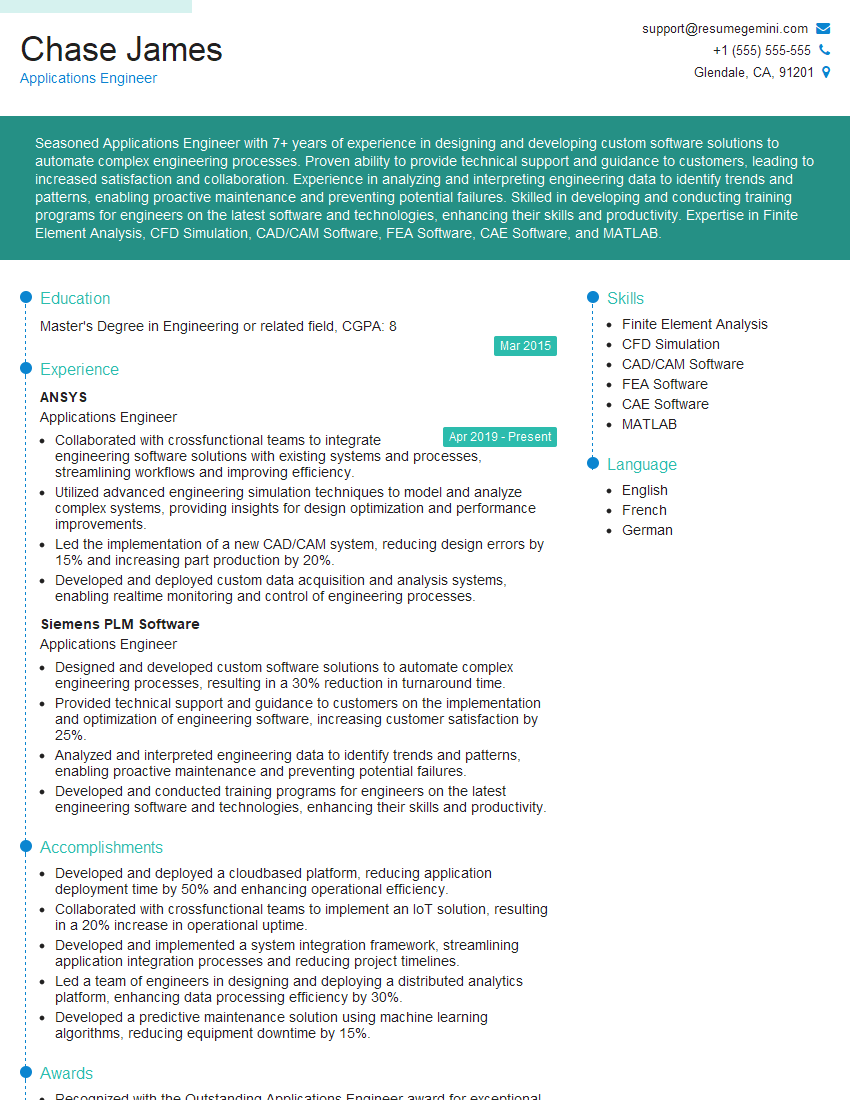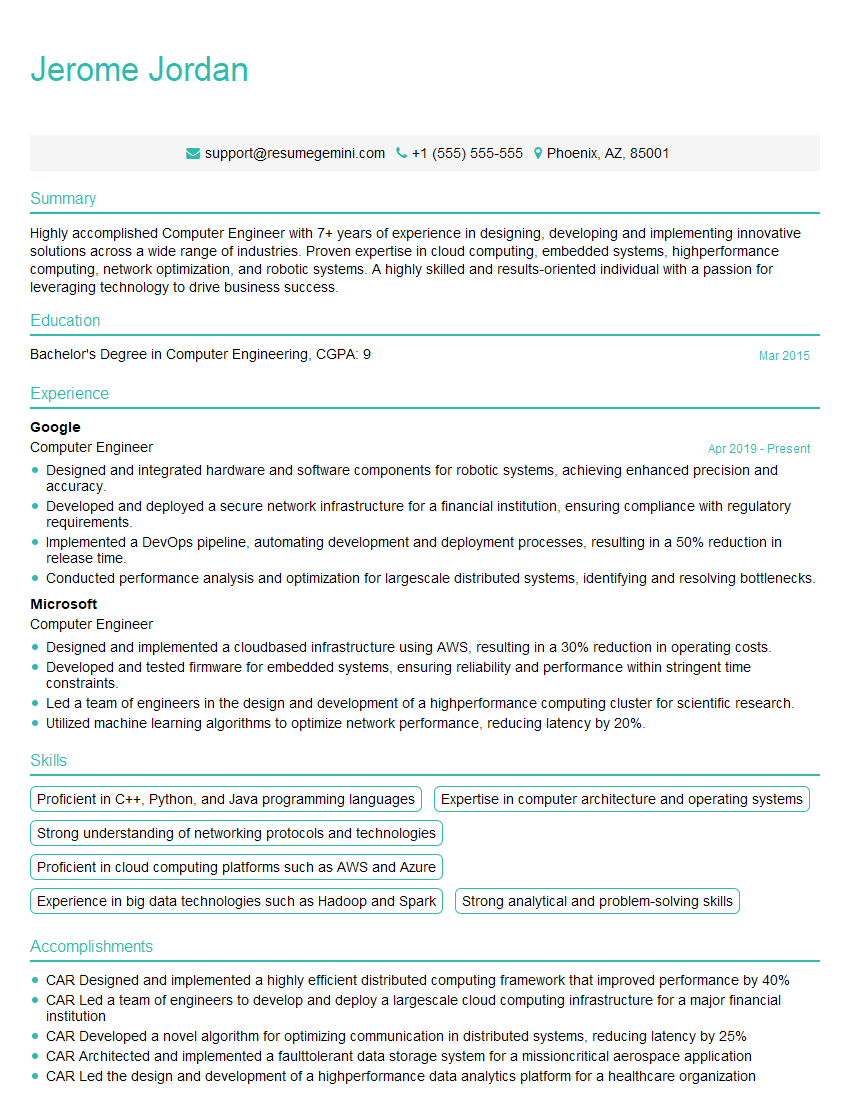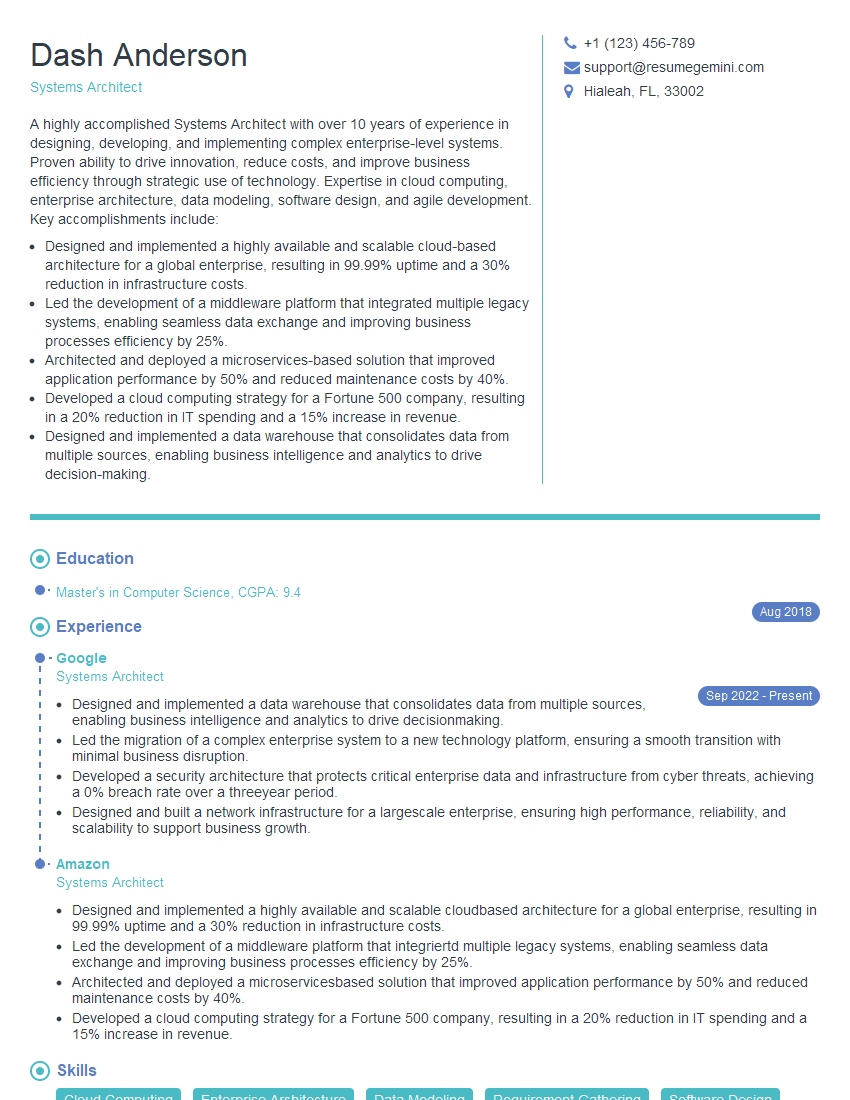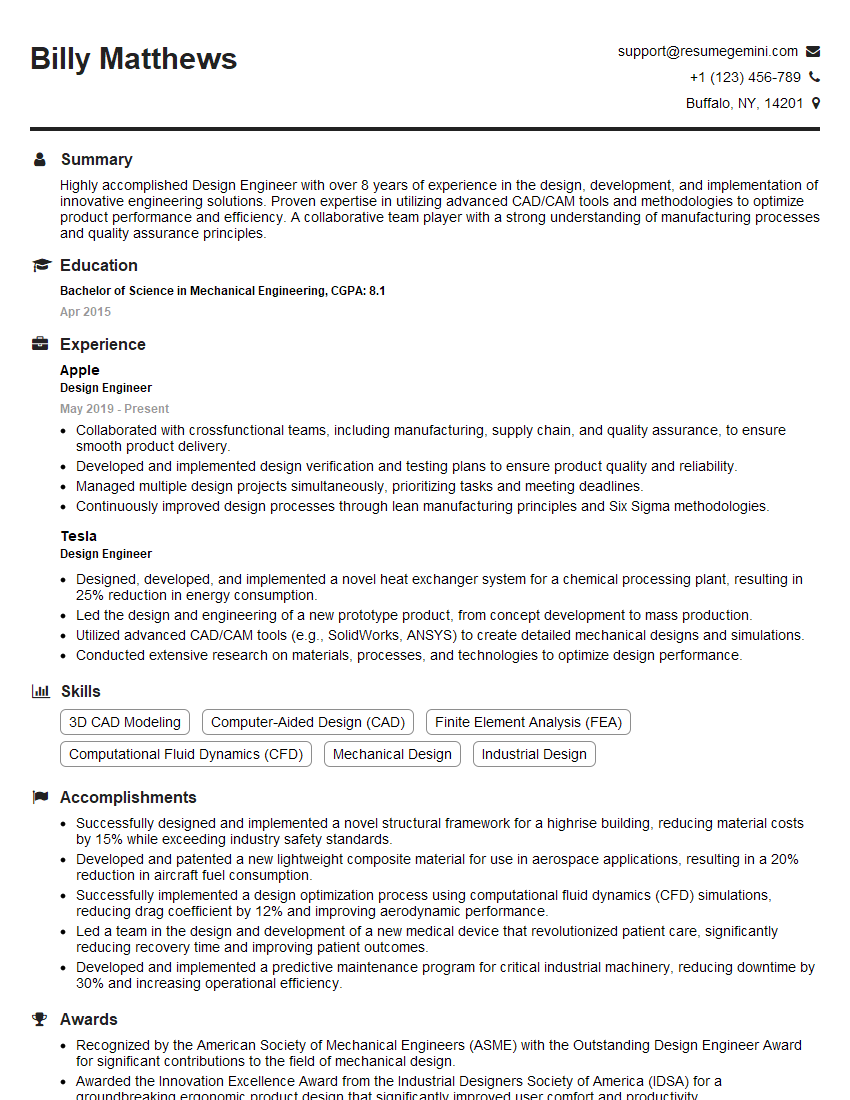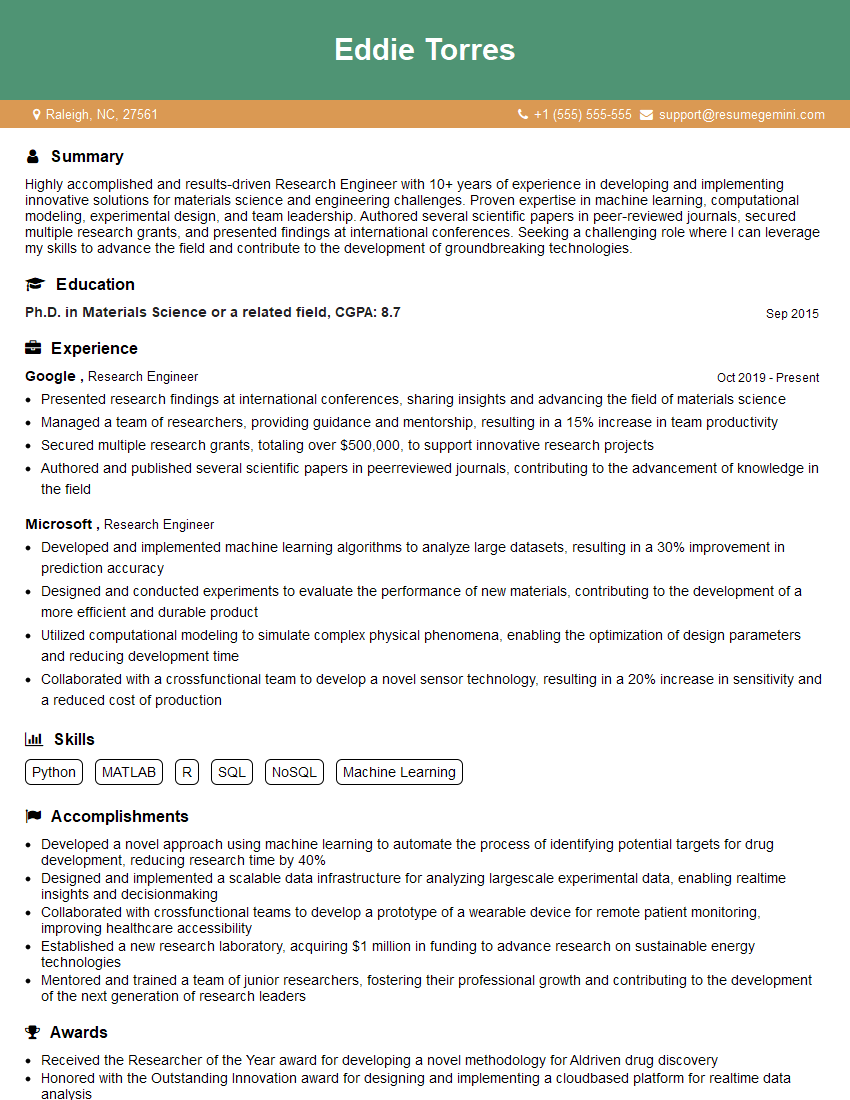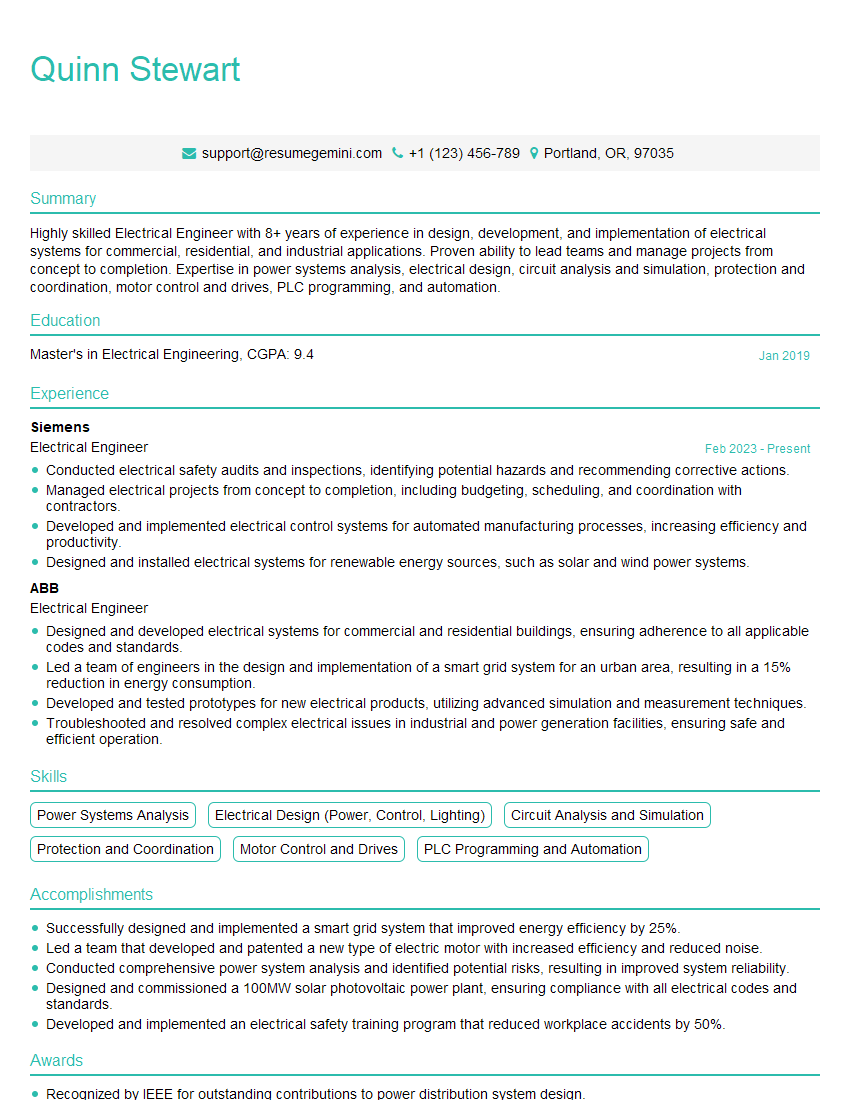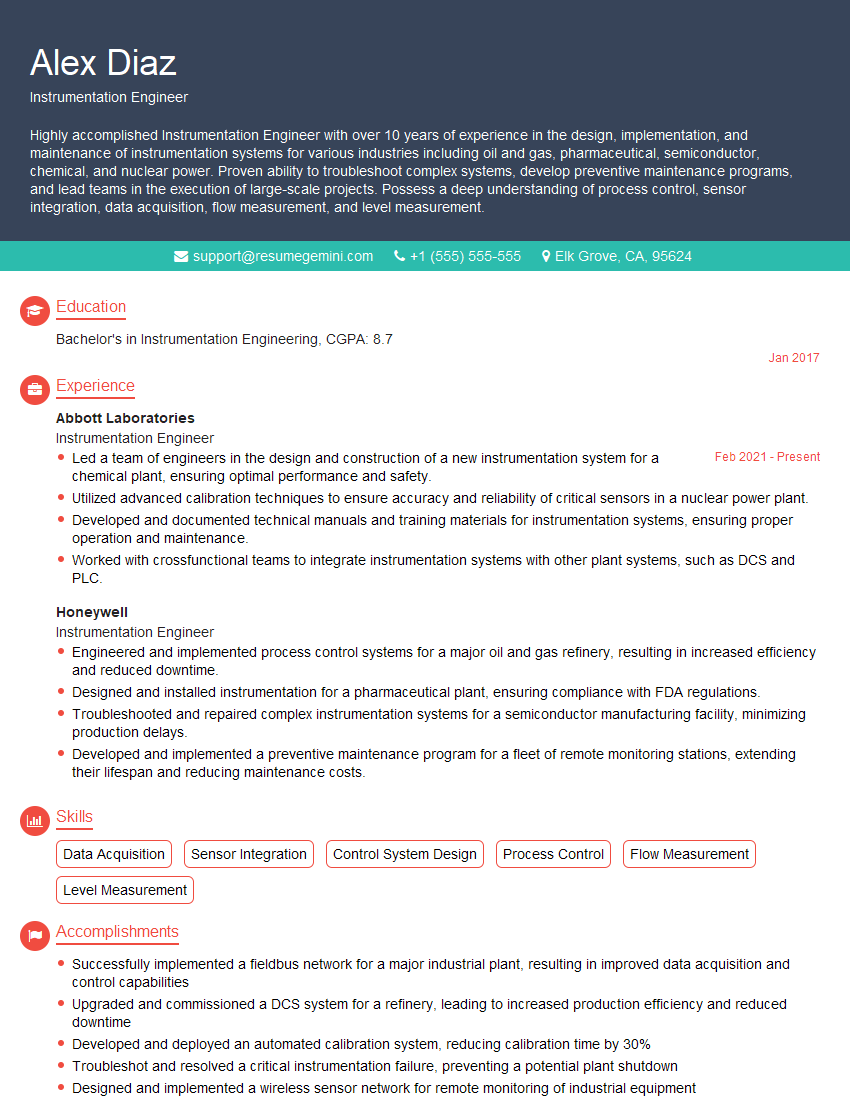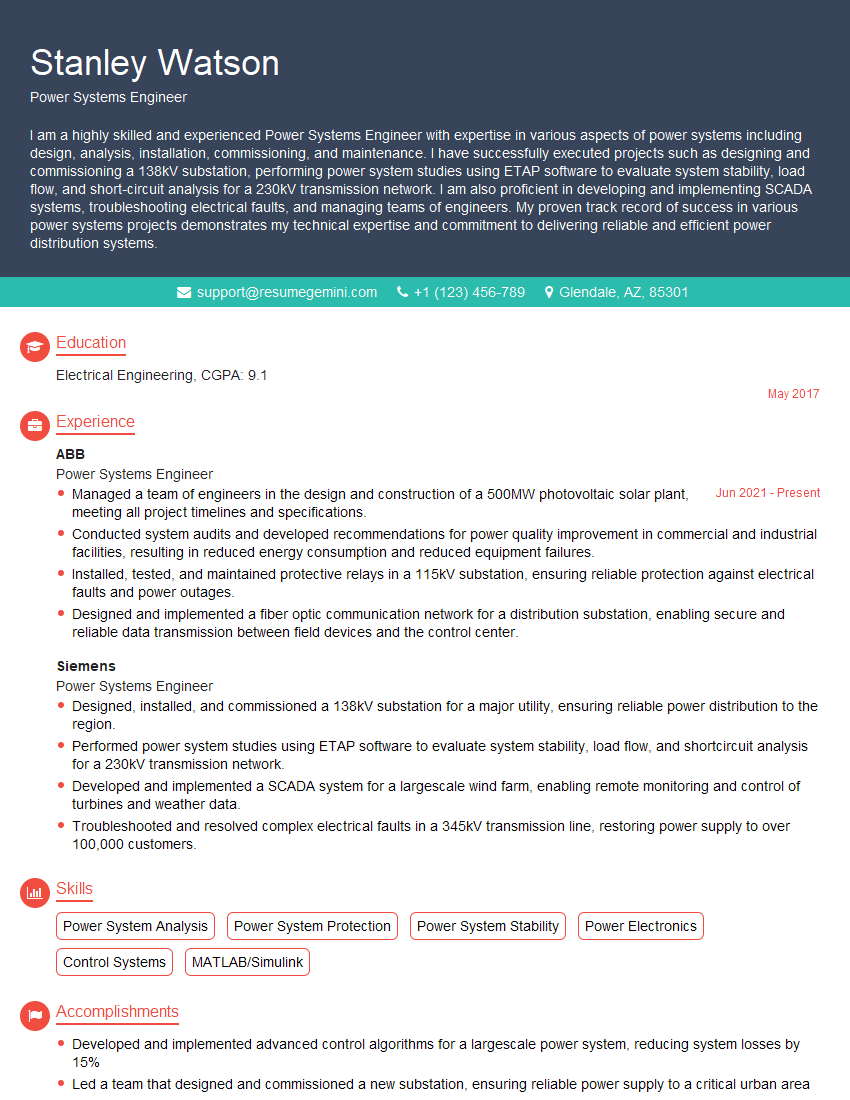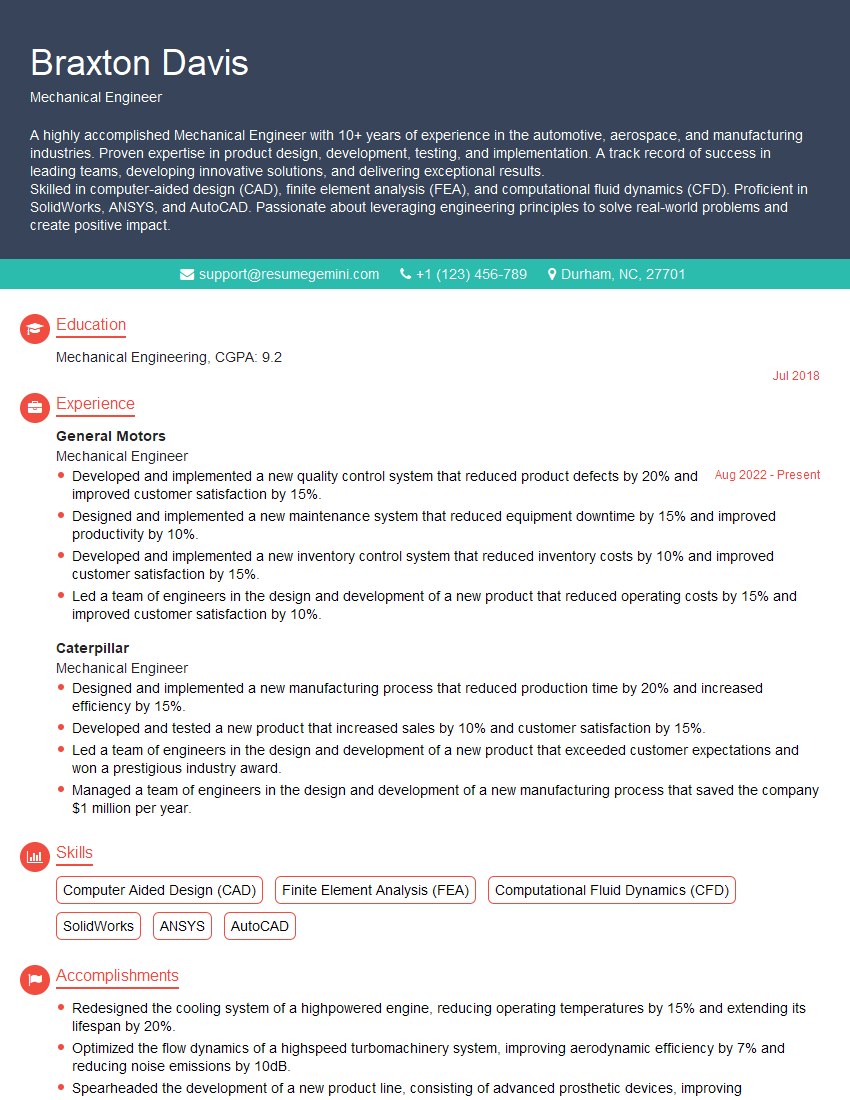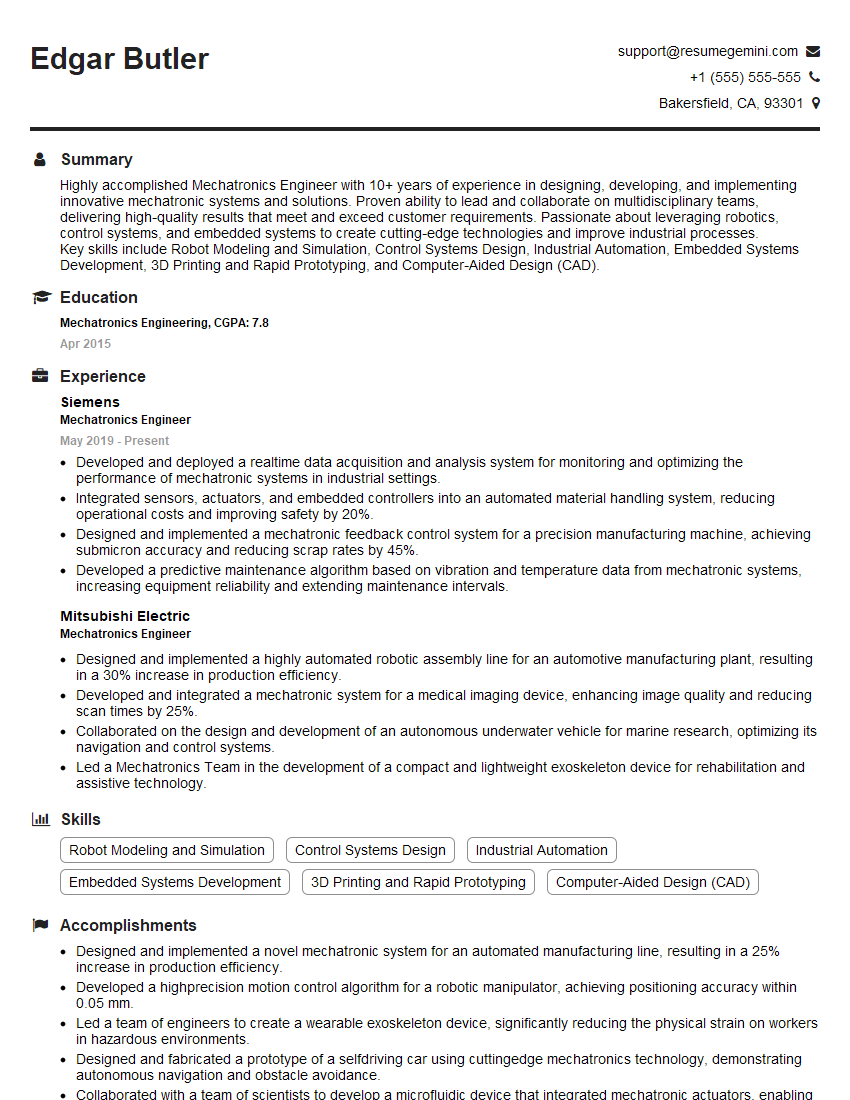Cracking a skill-specific interview, like one for Knowledge of mechanical, electrical, and computer engineering fields, requires understanding the nuances of the role. In this blog, we present the questions you’re most likely to encounter, along with insights into how to answer them effectively. Let’s ensure you’re ready to make a strong impression.
Questions Asked in Knowledge of mechanical, electrical, and computer engineering fields Interview
Q 1. Explain the difference between AC and DC motors.
The fundamental difference between AC (Alternating Current) and DC (Direct Current) motors lies in the type of electrical current they use to generate rotational motion. DC motors run on a constant voltage, resulting in a unidirectional current flow that produces a consistent magnetic field, leading to a relatively stable torque. Think of a simple battery powering a toy car motor – that’s DC. AC motors, on the other hand, operate on an alternating voltage, where the current periodically reverses direction. This creates a fluctuating magnetic field, requiring more intricate designs to produce consistent rotation. Most household appliances like fans and refrigerators use AC motors, leveraging the readily available AC power from the grid.
Here’s a table summarizing key differences:
| Feature | DC Motor | AC Motor |
|---|---|---|
| Current | Direct Current (unidirectional) | Alternating Current (periodically reversing) |
| Power Supply | Batteries, DC power supplies | Mains power supply (AC) |
| Torque Characteristics | Generally higher starting torque | Variable, depending on motor type |
| Maintenance | Generally lower maintenance | Can require more maintenance due to brushes (in some types) |
| Speed Control | Easier to control speed | Can be more challenging to precisely control speed |
Choosing between AC and DC motors depends on the application. DC motors are often preferred in applications requiring precise speed control and high starting torque, such as robotic systems. AC motors are generally preferred for applications needing high power and efficiency, like industrial machinery due to their robustness and less maintenance needs.
Q 2. Describe the working principle of a hydraulic system.
Hydraulic systems use pressurized liquid, typically oil, to transmit power and perform mechanical work. Imagine squeezing a toothpaste tube – the pressure you apply is transmitted through the tube to the toothpaste at the end. A hydraulic system works similarly, but on a larger scale and with precise control. A pump generates high pressure in the liquid. This pressurized fluid is then directed through valves and actuators (like hydraulic cylinders or motors) to perform specific tasks. The force generated is proportional to the pressure and the area of the actuator.
The working principle involves Pascal’s Law, which states that pressure applied to a confined fluid is transmitted equally in all directions. This allows a small force applied to a small area (at the pump) to generate a large force over a larger area (at the actuator). Think of a hydraulic jack used to lift a car – a small pump handle can lift a heavy vehicle because of the pressure amplification provided by the hydraulic system.
A typical hydraulic system consists of:
- Reservoir: Stores the hydraulic fluid
- Pump: Pressurizes the fluid
- Valves: Control the flow and direction of the fluid
- Actuators: Convert fluid pressure into mechanical work (cylinders, motors)
Hydraulic systems are used extensively in heavy machinery (e.g., excavators, bulldozers), aircraft, and industrial automation due to their ability to transmit large forces and their precise control capabilities. However, they also have drawbacks including potential for leaks, requiring regular maintenance, and the use of environmentally sensitive fluids.
Q 3. What are the different types of sensors used in industrial automation?
Industrial automation relies heavily on various types of sensors to monitor and control processes. These sensors convert physical quantities (temperature, pressure, light, etc.) into electrical signals that can be interpreted by a control system.
Here are some common types:
- Temperature Sensors: Thermocouples, RTDs (Resistance Temperature Detectors), and thermistors measure temperature variations.
- Pressure Sensors: Piezoresistive, capacitive, and strain gauge sensors measure pressure changes in liquids or gases. These are crucial in monitoring process pressures in chemical plants or hydraulic systems.
- Proximity Sensors: Inductive, capacitive, and photoelectric sensors detect the presence or absence of an object without physical contact. Widely used in robotic assembly lines to detect parts or in safety systems.
- Flow Sensors: Measure the rate of fluid flow (liquids or gases). Examples include ultrasonic and turbine flow meters; essential for monitoring fluid flow in pipelines.
- Level Sensors: Detect the level of liquids or solids in a container. Ultrasonic, capacitive, and float-type sensors are commonly used in storage tanks and industrial processes.
- Force/Torque Sensors: Measure the force or torque applied to an object. Used in robotics and machine monitoring for load measurement.
- Light Sensors (Photodiodes, Phototransistors): Detect changes in light intensity, useful in automation applications that require optical detection.
The choice of sensor depends on the specific application, required accuracy, and environmental conditions. For instance, a high-temperature environment might necessitate using a thermocouple rather than a thermistor.
Q 4. Explain the concept of PID controllers.
PID (Proportional-Integral-Derivative) controllers are widely used in control systems to maintain a desired output value. Imagine trying to maintain the temperature of a room using a thermostat. The PID controller acts like a sophisticated thermostat, constantly adjusting the heating/cooling system to reach and maintain the set temperature.
It uses three control terms to achieve this:
- Proportional (P): This term is proportional to the error (difference between the desired and actual value). A larger error leads to a stronger corrective action. Think of it as the immediate response – if the room is far too cold, the heater will turn on at full power.
- Integral (I): This term addresses the cumulative error over time. It helps to eliminate steady-state error – even if the proportional term has settled, the integral term continuously corrects any residual difference. Imagine if there’s a small, constant heat leak, the integral term will slowly adjust the heater to compensate.
- Derivative (D): This term accounts for the rate of change of the error. It anticipates future errors and helps to prevent overshoot and oscillations. Think of it as dampening – if the temperature is approaching the setpoint rapidly, the derivative term will reduce the heater output to prevent overshooting.
The PID controller adjusts the output by combining these three terms: Output = Kp * Error + Ki * ∫Error dt + Kd * d(Error)/dt, where Kp, Ki, and Kd are tuning constants that determine the relative contribution of each term. Tuning these constants is crucial for optimal controller performance. Incorrect tuning can lead to instability, oscillations, or slow response.
PID controllers are ubiquitous in industrial processes, robotics, and many other applications needing accurate control of variables.
Q 5. How does a microprocessor differ from a microcontroller?
While both microprocessors and microcontrollers are integrated circuits (ICs) that perform computations, they have distinct architectural differences and applications. Think of a microprocessor as the ‘brain’ of a computer, capable of complex calculations, while a microcontroller is a more specialized ‘brain’ designed for embedded systems.
Here’s a breakdown:
- Microprocessor: A general-purpose processor with a complex instruction set architecture (CISC). It lacks built-in peripherals and requires external memory and input/output (I/O) interfaces. It’s designed for high-performance computations in larger systems. Examples include Intel Core i7 and AMD Ryzen processors in desktop computers.
- Microcontroller: A specialized processor with a simpler instruction set architecture (RISC), usually integrated with memory, peripherals (timers, ADCs, UARTs), and I/O interfaces on a single chip. It’s designed for controlling specific devices or systems with low power consumption. Examples include Arduino and ESP32 used in IoT devices and embedded applications.
In essence, a microprocessor requires external components to function as a complete system, while a microcontroller incorporates essential functionalities within a single package. This makes microcontrollers suitable for embedded systems that require smaller size, lower power, and cost-effectiveness. Microprocessors are preferred for complex calculations and larger scale systems requiring high processing power.
Q 6. Describe the different types of memory in a computer system.
Computer systems employ various types of memory to store data and instructions. These memories differ in speed, cost, and volatility (whether they retain data when power is lost).
The main types include:
- RAM (Random Access Memory): Volatile memory that stores data temporarily while the computer is running. It’s fast and allows for quick access to data. When the power is off, data is lost. Think of it as your computer’s short-term memory.
- ROM (Read-Only Memory): Non-volatile memory that stores permanent instructions (firmware) that are crucial for booting the system. The data cannot be easily changed. Think of it as the computer’s long-term memory containing essential startup instructions.
- Cache Memory: A small, very fast memory located between the CPU and RAM. It stores frequently accessed data for faster retrieval. This significantly speeds up the system by reducing the time it takes to fetch data from RAM.
- Secondary Storage: Non-volatile memory devices, such as hard disk drives (HDDs), solid-state drives (SSDs), and USB flash drives, that store large amounts of data persistently. They are slower than RAM but are essential for permanent data storage.
Each memory type plays a critical role in the overall functionality of a computer system. RAM allows for fast processing, ROM ensures proper system startup, cache improves performance, and secondary storage provides permanent data storage capacity.
Q 7. What are the various stages in the design process of a mechanical component?
The design process of a mechanical component typically involves several stages, often iterative in nature. Consider designing a simple gear – the process isn’t just about drawing the shape; it involves thorough analysis and considerations.
The stages generally include:
- Needs Identification and Conceptualization: Define the purpose, requirements, and specifications of the component. What function should this gear perform? What forces will it endure? What material and manufacturing processes are feasible?
- Preliminary Design: Generate initial design concepts, sketches, and conceptual models. Explore several design alternatives. This is where you might sketch various gear types, sizes and tooth profiles.
- Detailed Design: Develop detailed drawings, 3D models (CAD), and specifications for the chosen design. This includes defining precise dimensions, tolerances, material properties, and surface finishes.
- Analysis and Simulation: Use computer-aided engineering (CAE) tools (e.g., Finite Element Analysis -FEA) to simulate the component’s behavior under various loading conditions. For example, you might simulate gear meshing and calculate stresses on teeth to ensure durability.
- Prototyping and Testing: Create prototypes and conduct tests to validate the design and performance. This could involve creating a 3D-printed prototype or a simple model to test the basic functionality. Actual gear prototype will be tested for strength and wear.
- Manufacturing: Select the manufacturing processes and finalize the production drawings. Deciding whether to machine the gear, cast it, or use additive manufacturing will depend on factors such as production volume, cost, and required precision.
- Testing and Refinement: Evaluate the manufactured components and make any necessary adjustments or improvements based on testing results. This stage can lead to iterative design modifications.
Throughout the process, collaboration among engineers and consideration of factors like manufacturing constraints, material availability, and cost-effectiveness are crucial for successful component design.
Q 8. Explain the concept of Finite Element Analysis (FEA).
Finite Element Analysis (FEA) is a powerful computational method used to predict how a product reacts to real-world forces, vibration, heat, fluid flow, and other physical effects. Imagine trying to understand how a bridge will withstand the weight of traffic – testing a real bridge is expensive and risky. FEA allows engineers to create a virtual model of the bridge, breaking it down into thousands of smaller, simpler elements (hence ‘finite elements’). We then apply the forces and other factors virtually, and the software calculates the stress, strain, and displacement at each element. This provides a detailed picture of the bridge’s behavior without building a physical prototype.
The process typically involves:
- Geometric Modeling: Creating a 3D representation of the object.
- Meshing: Dividing the model into smaller elements (like a jigsaw puzzle).
- Material Properties: Defining the material characteristics of each element (e.g., steel, aluminum).
- Boundary Conditions: Specifying how the object is supported and loaded.
- Solution: Solving the system of equations to determine the response of each element.
- Post-Processing: Analyzing the results (stress, strain, displacement) to assess the design.
FEA is used extensively in various industries, including automotive, aerospace, and civil engineering, to optimize designs, reduce material costs, and ensure product safety. For example, FEA can help determine the optimal thickness of a car chassis to withstand impact forces in a crash simulation, or predict the fatigue life of a turbine blade in a jet engine.
Q 9. What are the different types of transistors and their applications?
Transistors are the fundamental building blocks of modern electronics, acting as switches or amplifiers for electrical signals. There are two main types: Bipolar Junction Transistors (BJTs) and Field-Effect Transistors (FETs). Within FETs, we have further classifications like MOSFETs (Metal-Oxide-Semiconductor Field-Effect Transistors) and JFETs (Junction FETs).
- Bipolar Junction Transistors (BJTs): BJTs use current to control current. They are simpler to understand and can switch faster than some FETs, but they generally consume more power. They are used in amplifiers, switches, and other analog circuits.
- Field-Effect Transistors (FETs): FETs use voltage to control current, making them more energy-efficient than BJTs. They are prevalent in digital circuits and integrated circuits (ICs).
- MOSFETs: These are the most common type of FET, used extensively in microprocessors, memory chips, and other digital integrated circuits. They are known for their high input impedance and low power consumption. Different types of MOSFETs exist, such as NMOS (N-channel MOSFET) and PMOS (P-channel MOSFET), which are used together in complementary metal-oxide-semiconductor (CMOS) technology.
- JFETs: JFETs are less common than MOSFETs but offer advantages in certain high-frequency applications. They are sometimes preferred for their lower noise characteristics.
Think of a water valve: a BJT is like a valve where the amount of water flowing depends on how much you turn the handle (current control), whereas a FET is like a valve where the amount of water flowing depends on how high you lift a gate (voltage control).
Q 10. Describe the working principle of a three-phase induction motor.
A three-phase induction motor is a type of AC motor that doesn’t require external power to the rotor (the rotating part). Its operation relies on the interaction between a rotating magnetic field produced by the stator (the stationary part) and the induced currents in the rotor.
Here’s how it works:
- Three-phase power supply: The stator windings are connected to a three-phase AC power supply. This creates a rotating magnetic field that sweeps around the stator at a synchronous speed determined by the frequency of the supply and the number of poles in the motor.
- Rotating magnetic field: The three-phase currents create a magnetic field that rotates at a constant speed. You can visualize this as three magnets positioned around a circle, each being activated sequentially to create the illusion of a single rotating magnet.
- Induced currents: As the rotating magnetic field sweeps past the rotor conductors (usually copper bars or windings), it induces electromotive force (EMF) according to Faraday’s law of induction. This EMF in turn causes currents to flow in the rotor conductors.
- Interaction of magnetic fields: The induced rotor currents produce their own magnetic field which interacts with the rotating magnetic field of the stator. This interaction creates a torque, causing the rotor to spin.
- Slip: The rotor speed will always be slightly less than the synchronous speed of the rotating magnetic field. This difference is called slip and is necessary to induce currents in the rotor. Without slip, there would be no torque production.
Three-phase induction motors are widely used in industrial applications due to their robustness, simplicity, and relatively low cost. They are found in pumps, compressors, fans, and many other machinery.
Q 11. Explain the concept of signal conditioning.
Signal conditioning refers to the process of modifying or transforming a measured signal into a more suitable form for further processing, display, or storage. Think of it as preparing raw data for use. The raw signal often contains unwanted noise or is not in the appropriate format for the next stage.
Typical signal conditioning tasks include:
- Amplification: Increasing the amplitude of the signal to improve its signal-to-noise ratio (SNR).
- Attenuation: Reducing the amplitude of the signal to prevent overloading subsequent stages.
- Filtering: Removing unwanted noise or frequencies from the signal using filters (low-pass, high-pass, band-pass).
- Isolation: Protecting the measurement system from ground loops or other interference.
- Linearization: Correcting for non-linear relationships between the input and output of a sensor.
- Conversion: Changing the signal from one form to another (e.g., analog to digital conversion (ADC)).
For example, a sensor might produce a weak signal with a lot of noise. Signal conditioning would amplify the signal, filter out the noise, and then convert it to a digital format for a computer to process.
Q 12. What are the different types of communication protocols used in embedded systems?
Embedded systems often utilize various communication protocols to exchange data with other devices or systems. The choice of protocol depends on factors such as data rate, distance, power consumption, and the nature of the application.
Common protocols include:
- SPI (Serial Peripheral Interface): A synchronous, full-duplex communication protocol that is simple and widely used for short-distance communication between microcontrollers and peripherals (e.g., sensors, displays).
- I2C (Inter-Integrated Circuit): A multi-master, multi-slave protocol that uses only two wires for communication. It’s often used for low-speed communication between multiple devices on a bus.
- UART (Universal Asynchronous Receiver/Transmitter): A simple, asynchronous serial communication protocol that is commonly used for communication with computers and other devices, often through RS-232 or similar interfaces.
- CAN (Controller Area Network): A robust, high-speed protocol used in automotive and industrial applications for reliable communication in noisy environments.
- Ethernet: Widely used for high-speed data networking, often employed in more complex embedded systems requiring high bandwidth.
- USB (Universal Serial Bus): A versatile, widely used interface for connecting various peripheral devices to a host system.
- Bluetooth: A short-range wireless communication protocol commonly used in consumer electronics and wireless sensor networks.
- Wi-Fi: Another popular wireless technology for connecting embedded systems to networks.
Choosing the right communication protocol is crucial for efficient and reliable data transfer in embedded systems. For example, a low-power sensor node in a remote location might use I2C or Bluetooth Low Energy for communication, while a high-speed industrial controller might utilize Ethernet or CAN.
Q 13. Explain the concept of digital signal processing (DSP).
Digital Signal Processing (DSP) is a branch of electrical engineering and computer science that deals with the processing of signals that are in digital form. This involves converting analog signals (like sound waves or images) into digital form, manipulating the digital representation, and then often converting it back to analog if needed.
Key concepts in DSP include:
- Sampling: Converting a continuous-time analog signal into a discrete-time digital signal by taking samples at regular intervals. The sampling rate determines how accurately the original signal is represented.
- Quantization: Representing the amplitude of each sample using a finite number of bits. Higher bit depths result in more accurate representation but require more memory and processing power.
- Discrete Fourier Transform (DFT): A mathematical algorithm used to analyze the frequency components of a digital signal. It decomposes the signal into its constituent frequencies.
- Filtering: Removing or attenuating unwanted frequency components from a digital signal using digital filters. Common filters include low-pass, high-pass, and band-pass filters.
- Convolution: A mathematical operation used to combine two signals. This is fundamental in many DSP algorithms such as filtering.
DSP is used in countless applications, including audio processing (equalizers, noise reduction), image processing (image enhancement, compression), telecommunications (signal encoding and decoding), and many others. For instance, the noise-cancellation feature in many headphones uses DSP algorithms to identify and remove ambient noise from the audio signal.
Q 14. Describe the different types of gears and their applications.
Gears are toothed wheels used to transmit rotational motion and torque between shafts. Different types of gears are designed for specific applications based on factors such as speed ratio, torque transmission, and space constraints.
Common types include:
- Spur Gears: The simplest type, with teeth parallel to the axis of rotation. They’re efficient for transmitting power between parallel shafts but can be noisy at high speeds.
- Helical Gears: Have teeth angled along the axis, providing smoother and quieter operation compared to spur gears. They also handle higher loads and transmit more power.
- Bevel Gears: Used to transmit power between intersecting shafts. They come in various forms, including straight bevel, spiral bevel, and hypoid bevel gears, each with its own characteristics and applications.
- Worm Gears: Consist of a worm (screw-like gear) and a worm wheel. They offer high speed reduction ratios and self-locking capabilities. Often used in applications requiring high torque and low speed.
- Rack and Pinion Gears: Convert rotary motion into linear motion (or vice versa). Common in steering mechanisms in cars and industrial applications.
- Internal Gears: Have teeth on the inner surface of a ring. They allow for compact designs and are sometimes used to create planetary gear systems.
The choice of gear type depends on the application’s specific requirements. For example, a car’s transmission uses a combination of spur, helical, and planetary gears to provide different speed ratios, while a robotic arm might use rack and pinion gears for precise linear movement.
Q 15. What are the different types of welding techniques?
Welding is a fabrication process that joins materials, usually metals or thermoplastics, by causing coalescence. This is often done by melting the materials at the joint and allowing them to cool, solidifying the bond. Different welding techniques employ various methods of heating and melting the materials.
- Arc Welding: This uses an electric arc to melt the metals. Examples include Shielded Metal Arc Welding (SMAW), Gas Metal Arc Welding (GMAW), and Gas Tungsten Arc Welding (GTAW). SMAW, commonly known as stick welding, uses a consumable electrode coated with flux. GMAW, or MIG welding, uses a continuous wire electrode and shielding gas. GTAW, or TIG welding, uses a non-consumable tungsten electrode and a separate filler material.
- Resistance Welding: This method uses electric resistance to generate heat at the joint, causing the materials to fuse. Examples include Spot Welding, Seam Welding, and Projection Welding. Spot welding is ideal for joining sheet metal, whereas seam welding creates a continuous weld.
- Oxy-Fuel Welding: This traditional method uses a mixture of oxygen and fuel gas (like acetylene) to produce a flame hot enough to melt the base materials. It’s a versatile method but requires skilled operators.
- Other Techniques: There are many other specialized techniques, including laser welding (using a high-powered laser), electron beam welding (using a focused beam of electrons), and ultrasonic welding (using high-frequency vibrations).
Choosing the right welding technique depends on factors such as material type, thickness, desired joint quality, and production speed. For instance, TIG welding is often preferred for its precision and clean welds, while MIG welding is faster and better suited for mass production.
Career Expert Tips:
- Ace those interviews! Prepare effectively by reviewing the Top 50 Most Common Interview Questions on ResumeGemini.
- Navigate your job search with confidence! Explore a wide range of Career Tips on ResumeGemini. Learn about common challenges and recommendations to overcome them.
- Craft the perfect resume! Master the Art of Resume Writing with ResumeGemini’s guide. Showcase your unique qualifications and achievements effectively.
- Don’t miss out on holiday savings! Build your dream resume with ResumeGemini’s ATS optimized templates.
Q 16. Explain the concept of power factor correction.
Power factor correction is the process of improving the power factor (PF) of an electrical system. The power factor represents the efficiency of electrical power usage. A low power factor indicates that a significant portion of the current is wasted, leading to increased energy costs and reduced system efficiency. It’s typically less than 1 and represents the cosine of the angle between voltage and current.
In AC circuits, inductive loads (like motors and transformers) cause the current to lag behind the voltage. This lagging current contributes to a low power factor. Power factor correction involves adding capacitive elements (capacitors) to the system to counteract the inductive reactance and bring the current and voltage closer to being in phase. This reduces the reactive power and improves the overall efficiency.
How it Works: Capacitors store electrical energy and release it back into the circuit, effectively compensating for the lagging current. By strategically placing capacitors in the circuit, you can improve the PF, reduce the amount of current drawn from the supply, and lower energy losses.
Benefits:
- Reduced energy costs
- Improved system efficiency
- Increased capacity of existing equipment
- Reduced voltage drops and improved voltage regulation
Example: Imagine a factory with many induction motors. These motors draw significant reactive power, leading to a low power factor. By installing capacitor banks, the factory can correct the power factor, leading to substantial savings on their electricity bill and potentially avoiding penalties from the utility company.
Q 17. What are the different types of network topologies?
Network topology refers to the physical or logical layout of nodes (computers, printers, etc.) and connections in a network. Different topologies offer various advantages and disadvantages in terms of performance, scalability, and cost.
- Bus Topology: All nodes are connected to a single cable (the bus). Simple to implement but a single point of failure; if the bus fails, the entire network goes down. Think of it like a single hallway with all rooms connected to it.
- Star Topology: All nodes connect to a central hub or switch. This is the most common topology, offering easy troubleshooting and scalability. If one node fails, the rest remain unaffected. Like a wheel with spokes connecting to the hub.
- Ring Topology: Nodes are connected in a closed loop. Data travels in one direction around the ring. Relatively simple but a single point of failure can significantly impact the network. It’s less common now.
- Mesh Topology: Nodes are interconnected with multiple paths between them. Highly reliable and fault-tolerant because multiple paths exist for data transmission. Common in telecommunications networks, but complex and expensive.
- Tree Topology: A hierarchical structure combining bus and star topologies. It’s efficient for large networks, but complexity can increase troubleshooting efforts. It resembles an upside-down tree.
- Hybrid Topology: A combination of multiple topologies to leverage their strengths and mitigate weaknesses. It provides flexibility but increases complexity.
The choice of topology depends on the size, complexity, and requirements of the network. For home networks, a star topology is common; large enterprise networks often employ a hybrid approach for optimal performance and reliability.
Q 18. Explain the concept of object-oriented programming (OOP).
Object-Oriented Programming (OOP) is a programming paradigm based on the concept of “objects,” which contain data (attributes) and code (methods) that operate on that data. It’s a powerful approach to software development emphasizing modularity, reusability, and maintainability.
Key Principles:
- Abstraction: Hiding complex implementation details and showing only essential information to the user. Think of a car; you don’t need to know how the engine works to drive it.
- Encapsulation: Bundling data and methods that operate on that data within a single unit (the object). This protects data integrity and enhances code organization.
- Inheritance: Creating new classes (objects) based on existing ones, inheriting their properties and behaviors. This promotes code reuse and reduces redundancy.
- Polymorphism: The ability of objects of different classes to respond to the same method call in their own specific way. This allows for flexible and extensible code.
Example (Python):
class Dog: def __init__(self, name, breed): self.name = name self.breed = breed def bark(self): print("Woof!") myDog = Dog("Buddy", "Golden Retriever") myDog.bark() This simple example demonstrates encapsulation (data and method within the Dog class) and creating an object (myDog). OOP facilitates building complex software systems by breaking them down into manageable, reusable objects, making development, testing, and maintenance more efficient.
Q 19. What are the different types of databases used in engineering applications?
Various database types cater to the specific needs of engineering applications. The choice depends on factors like data volume, complexity, query types, and required performance.
- Relational Databases (RDBMS): These databases store data in tables with rows and columns, linked through relationships. Examples include MySQL, PostgreSQL, Oracle, and SQL Server. RDBMS are widely used in engineering for managing structured data like CAD drawings, material properties, or sensor readings. They’re excellent for querying and analyzing structured data.
- NoSQL Databases: These databases handle unstructured or semi-structured data and offer scalability and flexibility. Examples include MongoDB, Cassandra, and Redis. NoSQL databases are valuable in handling massive datasets from simulations or sensor networks where the data structure might not be rigidly defined.
- Object-Oriented Databases (OODBMS): These databases store data as objects, similar to OOP languages. They are suitable for applications dealing with complex objects and relationships, such as CAD models or geographic information systems.
- Graph Databases: These databases store data as nodes and edges representing relationships between them. They are well-suited for applications requiring analysis of relationships, like network analysis or social network analysis.
In practice, engineers might use a combination of database types. For example, a project might utilize a relational database for structured design data and a NoSQL database for storing and analyzing sensor data from a prototype test.
Q 20. Describe the different types of manufacturing processes.
Manufacturing processes transform raw materials into finished products. They can be broadly categorized based on the material and the techniques used.
- Casting: Molten material is poured into a mold and allowed to solidify. This is used for creating complex shapes, such as engine blocks or turbine blades.
- Forging: Metal is shaped using compressive forces, like hammering or pressing. Forging produces strong and durable parts, like connecting rods or crankshafts.
- Machining: Material is removed from a workpiece to achieve the desired shape and dimensions. This includes turning, milling, drilling, and grinding, used for creating precise parts with high accuracy.
- Sheet Metal Forming: Sheet metal is shaped by bending, stamping, or drawing. This is widely used for manufacturing car bodies, appliances, and electronic enclosures.
- Additive Manufacturing (3D Printing): Material is added layer by layer to create three-dimensional objects. This enables rapid prototyping and the creation of complex geometries that are difficult to produce using traditional methods.
- Welding (already discussed): Joining materials using heat or pressure.
- Powder Metallurgy: Metal powders are compacted and sintered (heated) to create a solid part. This process is suitable for producing porous materials or parts with complex internal structures.
The selection of manufacturing processes depends on factors like material properties, part geometry, required tolerances, production volume, and cost. For high-volume production of simple parts, casting or stamping might be cost-effective. For low-volume, high-precision parts, machining or additive manufacturing might be preferred.
Q 21. Explain the concept of stress and strain.
Stress and strain are fundamental concepts in mechanics describing how materials respond to forces.
Stress: Stress is the internal force per unit area within a material caused by an external load. It’s measured in Pascals (Pa) or pounds per square inch (psi). Imagine stretching a rubber band; the internal resistance to stretching is stress.
Strain: Strain is the deformation of a material caused by stress. It’s a dimensionless quantity representing the change in length or shape relative to the original dimensions. Continuing the rubber band example, the elongation of the rubber band is strain.
Relationship: The relationship between stress and strain is defined by the material’s constitutive law, often expressed as a stress-strain curve. This curve describes the material’s behavior under different load conditions. A linear elastic region indicates that stress and strain are directly proportional (Hooke’s Law), while plastic deformation occurs when the material permanently changes shape after the load is removed.
Types of Stress:
- Tensile Stress: Stretching or pulling force.
- Compressive Stress: Squeezing or pushing force.
- Shear Stress: Force acting parallel to the surface.
Practical Application: Understanding stress and strain is crucial for designing structures and components that can withstand anticipated loads without failure. Engineers use this knowledge to select appropriate materials, calculate component dimensions, and ensure safety and reliability in various applications.
Q 22. What are the different types of control systems?
Control systems are the backbone of automated processes, managing and regulating the behavior of dynamic systems. They range from simple on/off switches to complex algorithms controlling intricate machinery. Broadly, they are categorized into:
- Open-loop systems: These systems don’t use feedback to correct errors. Think of a simple toaster; you set the time, and it runs regardless of whether the bread is actually toasted. The output is independent of the actual outcome.
- Closed-loop systems (feedback systems): These systems use feedback from the output to adjust the input and maintain a desired state. A thermostat is a classic example; it measures the room temperature and adjusts the heating/cooling accordingly to maintain the setpoint. The output is continuously compared to the desired state, and adjustments are made to minimize errors.
- Linear systems: These systems exhibit a linear relationship between input and output. Their behavior can be easily modeled using linear equations. Many simplified models of mechanical systems, like a simple spring-mass-damper, fall into this category.
- Nonlinear systems: These systems have a non-linear relationship between input and output, making them more complex to analyze and control. Examples include robotic manipulators or chemical reactors where the dynamics are heavily dependent on the operating conditions.
The choice of control system depends on the application’s complexity, accuracy requirements, and cost considerations. Closed-loop systems are generally preferred for precision applications where feedback is crucial.
Q 23. Describe the concept of circuit analysis.
Circuit analysis is the process of determining the voltage, current, and power in different parts of an electrical circuit. It’s essentially solving a set of equations that describe how electricity flows through the circuit. We use fundamental laws like:
- Kirchhoff’s Current Law (KCL): The sum of currents entering a node (junction) is equal to the sum of currents leaving the node. Think of it like water flowing through pipes; the amount entering a junction must equal the amount leaving.
- Kirchhoff’s Voltage Law (KVL): The sum of voltages around any closed loop in a circuit is equal to zero. Imagine walking around a track; the total elevation change when you return to your starting point is zero.
- Ohm’s Law: The voltage across a resistor is proportional to the current flowing through it (V = IR).
These laws, combined with circuit element characteristics (resistors, capacitors, inductors), allow us to build mathematical models of circuits and solve them using various techniques like nodal analysis, mesh analysis, or superposition. For instance, nodal analysis focuses on solving for node voltages, while mesh analysis focuses on loop currents. Software tools like SPICE greatly simplify this process for complex circuits.
Circuit analysis is essential for designing and troubleshooting electrical and electronic systems, ensuring they operate as intended and are safe.
Q 24. Explain the concept of data structures and algorithms.
Data structures are ways of organizing and storing data in a computer so that it can be used efficiently. Algorithms are step-by-step procedures for solving a specific problem. They work hand-in-hand; choosing the right data structure is crucial for the efficiency of an algorithm.
Examples of data structures include:
- Arrays: Ordered collections of elements of the same data type.
- Linked Lists: Collections of elements where each element points to the next.
- Trees: Hierarchical data structures with a root node and branches.
- Graphs: Collections of nodes and edges representing relationships between them.
- Hash Tables: Data structures that use a hash function to map keys to values for fast lookups.
Algorithms use these structures to perform operations like searching, sorting, inserting, and deleting data. The choice of data structure significantly impacts the algorithm’s performance. For example, searching an array takes O(n) time (linear), while searching a sorted array using binary search takes O(log n) time (logarithmic), which is far more efficient for large datasets.
Understanding data structures and algorithms is fundamental to computer science, influencing the performance and scalability of software applications.
Q 25. What are the different types of software development methodologies?
Software development methodologies are frameworks that guide the development process. They provide structure and processes to manage projects, improve collaboration, and ensure quality. Some prominent methodologies include:
- Waterfall: A linear sequential approach where each phase (requirements, design, implementation, testing, deployment) must be completed before the next begins. It’s suitable for projects with stable requirements.
- Agile: An iterative and incremental approach focusing on flexibility and collaboration. It emphasizes frequent feedback loops and adapts to changing requirements. Scrum and Kanban are popular Agile frameworks.
- DevOps: A set of practices that automates and integrates the processes between software development and IT operations teams. It aims to shorten the systems development life cycle and provide continuous delivery.
- Spiral: A risk-driven approach that combines elements of waterfall and prototyping. It involves iterative cycles with risk assessment and mitigation at each stage.
The choice of methodology depends on factors like project size, complexity, and client involvement. Agile methodologies are generally preferred for projects with evolving requirements, while waterfall might be suitable for well-defined projects with minimal anticipated changes.
Q 26. Explain the concept of version control systems.
Version control systems (VCS) are tools that track changes to files over time, allowing multiple developers to collaborate efficiently on a project. They maintain a history of all modifications, making it easy to revert to previous versions if needed. Popular examples include Git, SVN, and Mercurial.
Key features of VCS include:
- Branching and Merging: Allows developers to work on separate features simultaneously without affecting the main codebase. Branches can be merged back into the main line once they are complete.
- Revision History: Tracks every change made to the code, providing a complete audit trail.
- Collaboration: Enables multiple developers to work on the same project concurrently, managing conflicts efficiently.
- Rollback: Allows easy reversion to previous versions of the code if errors are introduced.
VCS are crucial for software development, ensuring code integrity, facilitating teamwork, and simplifying the management of complex projects.
Q 27. Describe your experience with CAD software.
I have extensive experience using various CAD software packages, including SolidWorks, AutoCAD, and Fusion 360. My proficiency extends beyond basic modeling to encompass advanced features such as finite element analysis (FEA) and simulations. In my previous role at [Previous Company Name], I used SolidWorks to design and model [Specific Project, e.g., a robotic arm]. This involved creating detailed 3D models, performing simulations to ensure structural integrity, and generating manufacturing drawings.
I’m comfortable with parametric modeling, allowing me to easily modify designs and explore different design iterations. My experience also includes using CAD software for generating technical documentation and creating realistic renderings for presentations. I’m proficient in utilizing the various tools and functionalities within each platform to optimize designs for manufacturing and functionality.
Q 28. Explain a challenging technical problem you solved and how you approached it.
During my work on [Specific Project, e.g., an autonomous underwater vehicle], we encountered a significant challenge in the vehicle’s propulsion system. The initial design suffered from unpredictable thrust variations, impacting the vehicle’s stability and maneuverability. This was due to complex hydrodynamic interactions between the propeller and the surrounding water which were not accurately captured in our initial simulations.
My approach involved a multi-faceted solution:
- Detailed Analysis: I first conducted a thorough analysis of the existing design, reviewing the propeller design, motor specifications, and the hydrodynamic model. We identified discrepancies between the simulated and experimental results.
- Experimental Validation: We conducted a series of experiments to gather precise data on the thrust variations under different operating conditions. This involved building a test rig and carefully measuring the thrust.
- Refined Model: Using the experimental data, we refined our hydrodynamic model, incorporating factors previously neglected. This involved utilizing Computational Fluid Dynamics (CFD) simulations to improve the accuracy of the predictions.
- Design Optimization: Based on the improved model, we iteratively optimized the propeller design and motor control algorithm to minimize thrust variations. This included exploring different propeller geometries and control strategies.
This systematic approach resulted in a significant improvement in the vehicle’s performance, enhancing its stability and maneuverability. The revised propulsion system improved precision and efficiency, ultimately leading to the successful completion of the project. This experience highlighted the importance of a holistic approach combining theoretical modeling, experimental validation, and iterative design optimization.
Key Topics to Learn for a Multidisciplinary Engineering Interview
Succeeding in interviews requiring knowledge of mechanical, electrical, and computer engineering demands a well-rounded understanding. Focus your preparation on these key areas:
Mechanical Engineering Fundamentals:
- Statics and Dynamics: Understanding forces, moments, and motion is crucial for analyzing mechanical systems.
- Thermodynamics: Knowledge of heat transfer, energy conversion, and engine cycles is essential for many applications.
- Materials Science: Familiarity with material properties, selection, and failure analysis is vital for design and manufacturing.
- Manufacturing Processes: Understanding machining, casting, and other manufacturing techniques is beneficial.
Electrical Engineering Fundamentals:
- Circuit Analysis: Mastering circuit laws (Ohm’s Law, Kirchhoff’s Laws) and analyzing various circuit topologies is fundamental.
- Electromagnetism: Understanding electromagnetic fields, induction, and motors/generators is crucial.
- Power Systems: Knowledge of power generation, transmission, and distribution is valuable in many roles.
- Digital Logic and Electronics: Understanding logic gates, digital signal processing, and microcontrollers is important for embedded systems.
Computer Engineering Fundamentals:
- Computer Architecture: Understanding CPU architecture, memory systems, and input/output devices is key.
- Operating Systems: Familiarity with operating system concepts, processes, and resource management is beneficial.
- Embedded Systems: Knowledge of programming microcontrollers and interacting with hardware is crucial for many applications.
- Data Structures and Algorithms: A strong foundation in data structures and algorithms is essential for efficient problem-solving.
Remember to connect theoretical concepts to practical applications and focus on developing strong problem-solving skills. Practice explaining your understanding clearly and concisely.
Next Steps
Mastering these multidisciplinary engineering concepts significantly enhances your career prospects, opening doors to diverse and challenging opportunities. To maximize your chances, creating an ATS-friendly resume is paramount. A well-structured resume highlights your skills and experience effectively, ensuring your application gets noticed. ResumeGemini is a trusted resource to help you build a professional and impactful resume that showcases your abilities. Examples of resumes tailored to multidisciplinary engineering roles are available to guide you. Invest time in crafting a compelling resume – it’s your first impression!
Explore more articles
Users Rating of Our Blogs
Share Your Experience
We value your feedback! Please rate our content and share your thoughts (optional).
What Readers Say About Our Blog
Hello,
We found issues with your domain’s email setup that may be sending your messages to spam or blocking them completely. InboxShield Mini shows you how to fix it in minutes — no tech skills required.
Scan your domain now for details: https://inboxshield-mini.com/
— Adam @ InboxShield Mini
Reply STOP to unsubscribe
Hi, are you owner of interviewgemini.com? What if I told you I could help you find extra time in your schedule, reconnect with leads you didn’t even realize you missed, and bring in more “I want to work with you” conversations, without increasing your ad spend or hiring a full-time employee?
All with a flexible, budget-friendly service that could easily pay for itself. Sounds good?
Would it be nice to jump on a quick 10-minute call so I can show you exactly how we make this work?
Best,
Hapei
Marketing Director
Hey, I know you’re the owner of interviewgemini.com. I’ll be quick.
Fundraising for your business is tough and time-consuming. We make it easier by guaranteeing two private investor meetings each month, for six months. No demos, no pitch events – just direct introductions to active investors matched to your startup.
If youR17;re raising, this could help you build real momentum. Want me to send more info?
Hi, I represent an SEO company that specialises in getting you AI citations and higher rankings on Google. I’d like to offer you a 100% free SEO audit for your website. Would you be interested?
Hi, I represent an SEO company that specialises in getting you AI citations and higher rankings on Google. I’d like to offer you a 100% free SEO audit for your website. Would you be interested?
good
